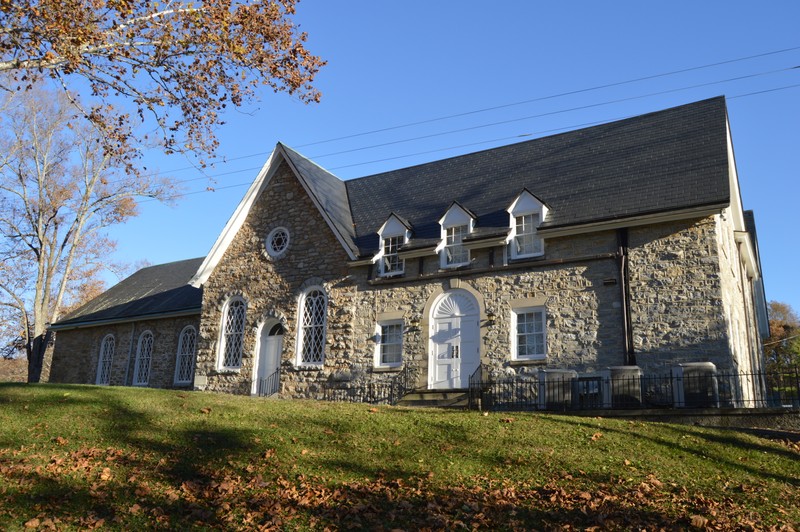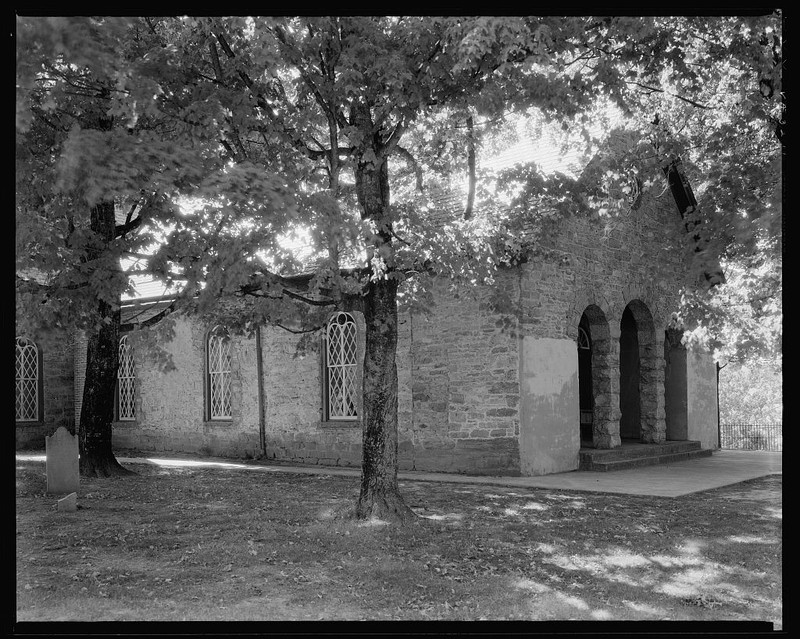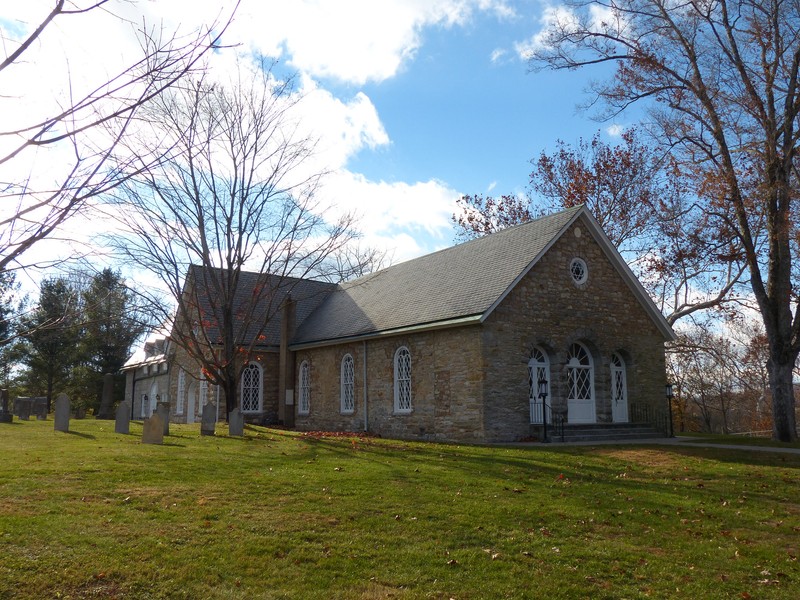Timber Ridge Presbyterian Church
Introduction
Text-to-speech Audio
Images

Timber Ridge Presbyterian Church, between 1930-39


Backstory and Context
Text-to-speech Audio
The Timber Ridge church, established by Irish immigrant John Blair in 1746, was one of the first four churches in the heavily Scots-Irish, predominantly Presbyterian area that would become Rockbridge County. The congregation met in a log structure until 1756, when a stone building was constructed approximately two miles south of the original site on an acre donated by John Houston. This church was of plain construction and, “devoid of prideful embellishment.”[1] It was also designed to be used as a fort in case of Indian raids. The current façade, including the porch with the triple-arch entrance, was constructed in 1871. The church was practically rebuilt in an 1899-1900 renovation; only parts of a few walls and several roof timbers remain from the 1756 structure. The church’s original, 1756 communion table does survive, and it is said to be, “the oldest known piece of Rockbridge County furniture.”[8] A two-story classroom wing was built in 1950.
John Blair, and the area churchgoers, belonged to “New Light” Presbyterianism, a division in the denomination dating back to 1741. This split originated in a debate over George Whitefield’s style of revivals and evangelism during the first Great Awakening (the “New Light” side was in favor). The fissure was resolved in 1758, mostly to the benefit of the much-more-successful “New Light” faction – the “Old Side” had been struggling since the split. The Timber Ridge church first received an assigned minister in 1753, John Brown, who they shared with nearby New Providence Presbyterian Church. Brown resigned from Timber Ridge in 1767; however, he remained at New Providence until 1798. William Graham was the pastor at Timber Ridge from 1776 to 1785; Graham was also the Rector of the fledgling Liberty Hall Academy, which the church supported and which was located nearby. (The school building was demolished in 1838.) His Academy moved to Lexington in 1779 and eventually became Washington and Lee University.
In 1789, New Providence divided in a debate over the use of Isaac Watts’s hymns; those opposed formed a new church, which is now known as Old Providence Associate Reformed Presbyterian Church. The Timber Ridge church was equally prone to faction; while exact reasons are unknown, it also split into two congregations, the “regular” Presbyterian church and the Associate Reformed Presbyterian church, sometime in the late 1700s. The cause was probably very similar to that at New Providence; the Associate Reformed Presbyterian church was founded on the principles of commitment to the Westminster Confession of Faith and singing only psalms in their services. The two now-distinct churches agreed to share the Timber Ridge building equally.
In 1805, offshoots of the Great Revival shook the Timber Ridge Presbyterian Church and surrounding community. One Ann Henderson, a young, female member, was taken with the “jerks” during a service on August 4th. This strange phenomenon – “involuntary convulsions in which the subjects’ head lashed violently backward and forward” – was claimed by some to be a movement of the Holy Spirit.[14] The “jerks” had begun in Tennessee around 1803. This was several years after the beginning of the Great Revival that swept through Appalachia with its all-day outside services and associated strange physical reactions. However, prominent churchgoer Samuel Houston believed Henderson was interrupting the service; he forcibly removed her from the premises and kept her at his house for two hours. While the law allowed church leaders to remove persons who were disrupting services, Houston was charged with assault and battery. The only way this charge could be sustained was if the “jerks” were, in fact, an involuntary, spiritual reaction to the message preached; the grand jury dismissed the case before it even came to trial. Eventually, the “jerks” were denounced by most religious leaders nationwide.
In the early 1850s, tensions began to rise between the “regular” and ARP factions at Timber Ridge. At one point, the “regular” Presbyterians locked the ARP members out of the building, forcing Maggie Gibson, daughter of prominent ARP member John Gibson, to climb into a window and unlock the church. A separate building, with bricks donated by John Gibson, was eventually built in 1856 and still stands directly across the road from the “regular” Presbyterian church.
The Timber Ridge Presbyterian Church is still active and holds services every Sunday. The churchyard cemetery is no longer used; the oldest of the several hundred graves there date back to 1773.
Cite This Entry
Woodard, Benjamin. "Timber Ridge Presbyterian Church." Clio: Your Guide to History. March 14, 2020. Accessed July 26, 2025. https://theclio.com/entry/96231
Sources
1) 081-0066 Timber Ridge Presbyterian Church, DHR: Virginia Department of Historic Resources. Accessed March 9th 2020. https://www.dhr.virginia.gov/historic-registers/081-0066/.
2) About Us, Old Providence Associate Reformed Presbyterian Church. Accessed March 9th 2020. http://www.oldprovidencechurch.org/aboutus.html.
3) Church History; About Us, Timber Ridge: Historic Presbyterian Church Built 1756. Accessed March 9th 2020. https://www.trpchurch.org/church-history/.
4) Clarke, Erskine. Associate Reformed Presbyterian Church, South Carolina Encyclopedia (University of South Carolina). July 6th 2016. Accessed March 9th 2020. http://www.scencyclopedia.org/sce/entries/associate-reformed-presbyterian-church/.
5) Coffey, David W. Maple Hall, National Register of Historic Places Inventory/Nomination Form, Virginia Division of Historic Landmarks (now Virginia Department of Historic Resources). January 29th 1987. Accessed March 9th 2020. https://www.dhr.virginia.gov/VLR_to_transfer/PDFNoms/081-0041_Maple_Hall_1987_Final_Nomination.pdf.
6) Cornerstone of Timber Ridge Associate Reformed Presbyterian Church, Flickr: photo by Jody Brumage. June 15th 2016. Accessed March 9th 2020. https://www.flickr.com/photos/jodybr/27568576853/in/photostream/.
7) Gaston, H. Neely. A Brief History of the Associate Reformed Presbyterian Church and Erskine Theological Seminary, The Christian Observer. March 1st 2009. Accessed March 9th 2020. https://christianobserver.org/a-brief-history-of-the-associate-reformed-presbyterian-church-and-erskine-theological-seminary/.
8) Isbell, Sherman. Archibald Alexander Travelogue: Site 1: Timber Ridge Presbyterian Church, The Westminster Presbyterian. Accessed March 9th 2020. http://www.westminsterconfession.org/the-doctrines-of-grace/archibald-alexander-travelogue.php.
9) Morton, Oren F.. A History of Rockbridge County Virginia. Staunton, Virginia. The McClure Company, Inc., 1920. Internet Archive. Accessed March 9th 2020. https://archive.org/details/historyofrockbri00mortrich/mode/2up.
10) Muether, John R.. The Story of Old Side Presbyterianism, The Orthodox Presbyterian Church. July 1996. Accessed March 9th 2020. https://www.opc.org/OS/html/V5/3b.html.
11) Smyth, S. Gordon. The Pioneer Presbyterians of New Providence, Va.: Part II. Journal of the Presbyterian Historical Society (1901-1930), vol. 11, no. 6, pp. 193 - 204. Published June 1st 1922. JSTOR. Accessed March 9th 2020. https://www.jstor.org/stable/23323415?seq=1#metadata_info_tab_contents.
12) Virginia Historic Landmarks Commission Staff. Church Hill, National Register of Historic Places Inventory/Nomination Form, Virginia Historic Landmarks Commission (now Virginia Department of Historic Resources). February 23rd 1979. Accessed March 9th 2020. https://www.dhr.virginia.gov/VLR_to_transfer/PDFNoms/081-0065_Church_Hill_1979_Final_Nomination.pdf.
13) Virginia Historic Landmarks Commission Staff. Timber Ridge Presbyterian Church, National Register of Historic Places Inventory/Nomination Form, Virginia Historic Landmarks Commission (now Virginia Department of Historic Resources). November 12th 1969. Accessed March 9th 2020. https://www.dhr.virginia.gov/VLR_to_transfer/PDFNoms/081-0066_Timber_Ridge_Presbyterian_Church_1969_Final_Nomination.pdf.
14) Winiarski, Douglas. A History of the Jerks: Bodily Exercises and the Great Revival (1803–1967), ArcGIS StoryMaps (Environmental Systems Research Institute, Inc.). Accessed March 9th 2020. https://arcg.is/18PTHm.
15) Winiarski, Doug. Jailing the Jerkers, Out of the Box: Notes from the Archives @ The Library of Virginia. June 21st 2017. Accessed March 9th 2020. http://www.virginiamemory.com/blogs/out_of_the_box/2017/06/21/jailing-the-jerkers/.
Wikipedia, Public Domain (https://commons.wikimedia.org/wiki/File:Timber_Ridge_PCUSA,_northern_side.jpg)
Library of Congress, Public Domain (https://www.loc.gov/item/2017892087/)
Kipp Teague, Flickr (https://www.flickr.com/photos/retroweb/32867020093/in/photostream/) - CC BY-NC-ND 2.0 (https://creativecommons.org/licenses/by-nc-nd/2.0/)

